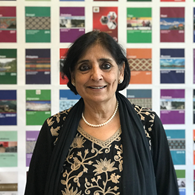What’s in a Name?
The Demographic and Health Surveys Program, 2013-2018
For those of us who have worked with the Demographic and Health Surveys over the last 30 years, we usually just say “theDHS” when we talk about them. As in, “I work atDHS”, or “I usedDHS data”, or “They’re doing aDHS”. In 1998, the Demographic and Health Surveys became a part of USAID’sMEASURE family, a group of projects doing survey and M&E work. While most people knew that our formal name was MEASURE DHS, among friends we were still just “TheDHS”.
And then suddenly, around 2008, we had acronym competition from the ‘other’DHS. That’s right: the Department of Homeland Security, no less. Imagine being in a foreign country, a meeting at USAID, or even at a cocktail party, mentioning you work for theDHS and having this interpreted as something entirely different (Danville High school, anyone?). So in 2013, whenUSAID’sMEASURE umbrella ceased to be, it was clear that we needed to be something more than simply “DHS”. But what? At first glance, “The Demographic and Health Surveys Program” or “The DHS Program” seems like an innocuous project name. But to us, it represents a lot more.
As a Program, we are representing not one contract withUSAID, but 30 years of data collection in more than 90 countries.
As a Program, we are not just our flagship household survey, but a suite of surveys, data management, biomarker testing and GIS and research activities.
As a Program, we encompass far more than just data collection, but are charged with strengthening capacity, communicating complex information, analyzing data, and ensuring thatDHS data are used to inform decisions all over the globe to improve the health of families and communities.
The DHS Program is no longer just a survey project. The surveys are the vehicles for training local data collection staff, strengthening lab capacity, informing journalists, and answering challenging research questions. The surveys are opportunities for global cooperation and diplomacy. The surveys are the tangible results of decades of U.S. contributions towards international development. What is captured in a DHS final report is only the tip of the iceberg.
The DHS Program has been given a tremendous opportunity to grow even larger in scope in the coming five years. We look forward to working with colleagues across the globe, and welcome conversation via our new blog platform.




I’m a nurse by profession currently studying BA in social work practice and development.Am interested in becoming part of the work force in DHS,but don’t know how to go about it.How do I join and what is the entry requirement? I have seen and heard people going for surveys in health related issues but have withheld information on how one ca become part of the team.I will be thankful if am considered.